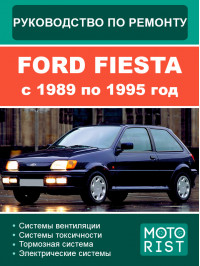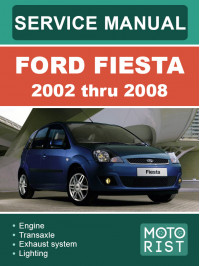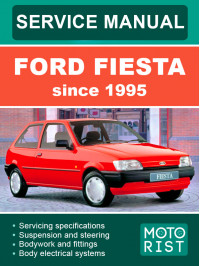Information on repair and maintenance of Ford Fiesta cars electronically
The Ford Fiesta is a B-segment passenger car developed by the European subsidiary of the American company Ford Motor Company and manufactured in Germany, Spain, Brazil, Mexico, China, India and South Africa. Since its introduction in 1976, seven different generations of the Fiesta have been produced and over twelve million units have been sold.
The first series Ford Fiesta was launched in May 1976 and was offered as a direct competitor to the Fiat 127, Opel Kadett City and Volkswagen Polo. The entry-level model was equipped with a 1.0-litre Kent engine producing 40 hp, the usual output for a car of this size at the time.
In September 1983, the second series Ford Fiesta was introduced, not unlike its ancestor from which it was descended. The second series received updated lines, a new front end with smaller rectangular headlights (which also included indicators on the sides, in the previous series they were located under the headlights), a thinner grille, a slightly more rounded tailgate and new taillights. The vehicle's aerodynamic coefficient has been reduced from 0.42 Cd to 0.40 Cd.
The most important innovation was the introduction of a five-speed manual transmission for the entire range, starting in 1984, the 4-speed transmission was retained only on the 957 cm³ versions.
The third generation was produced between 1989 and 1997. 5-door version appears for the first time In practice, this third generation has nothing to do with the first two, except for the name and some engines, the chassis is completely new. In 1994, the model was updated with new side mirrors, a new interior, new bumpers and richer equipment. During this period, the SI modification was produced with a 1.6 liter engine and 16 valves, featuring rounded bumpers.
The fourth generation Ford Fiesta, produced in 1995, has a more aerodynamic design than the third, but is still based on the same chassis. This can be seen in the basic shape of the car, which is similar to the third generation car, but more oval.
The fifth generation of the car was presented at the Frankfurt Motor Show in late 2001, and production began in early 2002. This is the biggest change in the history of the model, even more than the introduction of the third generation in 1989. With the exception of some details, the model has nothing in common with older generations. The platform and chassis are brand new. In early 2006, this generation received a facelift that saw changes to the bumpers, grille, front and rear lights, and the interior. This Fiesta has been redesigned and is a huge sales success.
The sixth generation Ford Fiesta is produced from 2008 to 2017. This new generation shares a platform with the Mazda 2. The larger, more spacious car was characterized by aggressively shaped large headlights, sharply shaped headlights, as well as numerous distinct ribs and a variety of taillights.
In order to make it easier to use and maintain your cars, on our website you can read, buy and download Ford Fiesta car repair books in PDF format. In the repair book you can get answers to your questions:
- how to replace the fuel pump with your own hands
- how to repair and replace a water pump;
- when and how to replace the timing belt;
- what are the causes of engine malfunctions and how to eliminate them;
- how often you need to take your car for maintenance and much more.
The repair book describes in detail the design of the car, the main characteristics, illustrations with detailed descriptions for various repairs. The information is accessible and understandable to everyone, presented as simply as possible, based on the experience of professionals over many years. After purchasing the book, you can download it to your phone or tablet and always have it at hand, without depending on the availability of the Internet in case of a car breakdown on the way.







